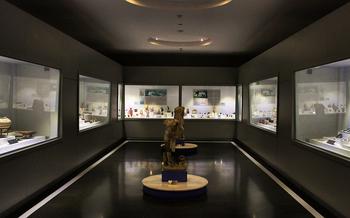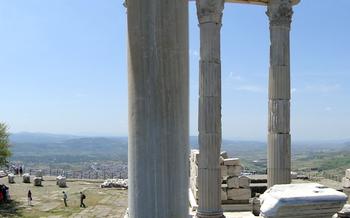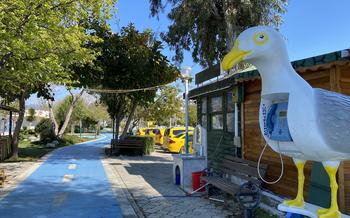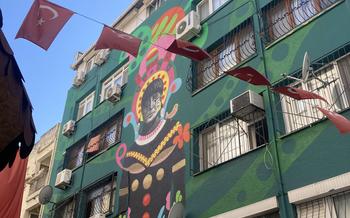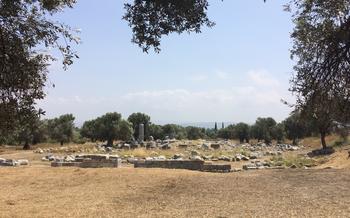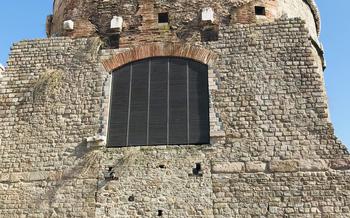
The Ancient City of Pergamon (Bergama)
- A Journey to the Past: Exploring the Ancient City of Pergamon
- Unveiling the Acropolis: A Masterpiece of Hellenistic Architecture
- Marveling at the Altar of Zeus: A Symbol of Power and Majesty
- Delving into the Pergamon Museum: A Treasure Trove of Ancient Artifacts
- Exploring the Asclepieum: A Sanctuary of Healing and Medicine
- Discovering the Red Basilica: A Byzantine Architectural Gem
- Strolling Through the Ancient Theater: A Stage for Drama and Spectacle
- Unearthing the Necropolis: A Glimpse into Ancient Burial Practices
- Discovering the Pergamon Museum: A Treasure Trove of Ancient Artifacts
- Exploring the Ancient Agora: The Heart of Public Life
- Admire the Zeus Temple: A Testament to Divine Power
- Uncover the Ancient Library: A Center of Knowledge
- Visit the Pergamon Museum in Berlin: A Journey Through Time
- Insider Tip: Embark on a Culinary Adventure
A Journey to the Past: Exploring the Ancient City of Pergamon
Pergamon, an ancient Greek city located in modern-day Turkey, was once the capital of the powerful Pergamon Kingdom. Its fascinating history, impressive architecture, and cultural significance make it a must-visit destination for any traveler seeking to delve into the depths of the ancient world.
The best time to visit Pergamon is during the spring or fall, when the weather is pleasant and conducive to outdoor exploration. Immerse yourself in the rich history of this ancient city by visiting its iconic landmarks, such as the Acropolis, the Altar of Zeus, and the Library of Pergamon. Don't miss the opportunity to attend cultural events, sample the local cuisine, and create unforgettable memories in this captivating destination.
Unveiling the Acropolis: A Masterpiece of Hellenistic Architecture
Perched atop a hill overlooking the city, the Acropolis of Pergamon stands as a testament to the grandeur and artistry of the ancient Greek world. As you approach, the sheer scale and majesty of this architectural marvel will leave you in awe. Enter through the monumental gateway and step into a realm where history and beauty intersect.
The Acropolis is a treasure trove of ancient wonders, each vying for your attention. Explore the sacred temples dedicated to Athena and Dionysus, marvel at the intricate carvings adorning their facades. Wander through the stoas, once bustling with philosophers and merchants, their colonnades casting intricate shadows on the ancient stones.
As you ascend the hill, the awe-inspiring Theater of Pergamon comes into view. With a seating capacity of over 10,000 spectators, this magnificent structure hosted theatrical performances, concerts, and public gatherings. Imagine the roar of the crowd as ancient dramas unfolded on its stage, transporting you back to a time when art and culture flourished.
Don't miss the opportunity to climb to the highest point of the Acropolis, where the remains of the fortifications stand guard. From here, you'll be rewarded with panoramic views that stretch for miles, encompassing the ancient city, the surrounding countryside, and the shimmering Aegean Sea in the distance. It's a breathtaking vista that will forever etch itself into your memory.
Insider tip: To avoid the crowds and enjoy a more intimate experience, visit the Acropolis early in the morning or late in the afternoon when the golden light of the setting sun casts a magical glow over the ruins.
Marveling at the Altar of Zeus: A Symbol of Power and Majesty
Amongst the ruins of Pergamon, the Altar of Zeus stands as a testament to the city's grandeur and artistic prowess. This monumental altar, dedicated to the king of the gods, was once the centerpiece of the city's Acropolis. Its intricate sculptures, depicting the Gigantomachy and other Greek myths, showcased the exceptional craftsmanship of the Pergamene artists.
The Altar of Zeus, with its imposing size and elaborate ornamentation, served as a symbol of the power and wealth of the Pergamon Kingdom. Its construction, commissioned by King Eumenes II in the 2nd century BC, reflected the desire of the kingdom to rival the cultural and artistic achievements of other Hellenistic cities.
While the original altar is now housed in the Pergamon Museum in Berlin, Germany, visitors to Pergamon can still admire its grandeur through replicas and exhibits. These displays provide a glimpse into the artistry and religious practices of the ancient Greeks, making the Altar of Zeus a must-see for anyone interested in ancient history and culture.
Delving into the Pergamon Museum: A Treasure Trove of Ancient Artifacts
Nestled in the heart of Berlin, Germany, the Pergamon Museum stands as a testament to the grandeur and artistry of ancient civilizations. This world-renowned museum houses some of the most iconic artifacts from the ancient world, including the awe-inspiring Pergamon Altar, the majestic Market Gate of Miletus, and the monumental Ishtar Gate of Babylon.
The Pergamon Altar, the museum's star attraction, is an architectural masterpiece that once adorned the Acropolis of Pergamon. With its intricate sculptures depicting the Gigantomachy, the altar offers a glimpse into the mythological world of ancient Greece. The Market Gate of Miletus, with its towering columns and intricate carvings, transports visitors to the bustling commercial center of an ancient Greek city.
The Ishtar Gate, once the entrance to the legendary city of Babylon, is a testament to the grandeur and power of the ancient Babylonian Empire. With its vibrant blue glazed tiles and majestic winged bulls, the gate invites visitors to step back in time and experience the splendor of one of the world's oldest civilizations.
In addition to these awe-inspiring artifacts, the Pergamon Museum offers a wealth of interactive displays and educational exhibits that provide visitors with a deeper understanding of ancient cultures and civilizations. Whether you're an art enthusiast, a history buff, or simply someone who appreciates the wonder of the ancient world, the Pergamon Museum is a must-visit destination.
Insider tip: To avoid the crowds and make the most of your visit, book your tickets online or arrive early. The museum also offers guided tours that provide fascinating insights into the history and significance of the artifacts on display.
Exploring the Asclepieum: A Sanctuary of Healing and Medicine
Just outside the ancient city of Pergamon, nestled amidst verdant surroundings, lies the Asclepieum, a sanctuary dedicated to the Greek god of healing, Asclepius. This sacred site was renowned throughout the ancient world for its healing powers and medical practices.
Enter the Asclepieum, and you'll be greeted by a serene atmosphere that whispers of ancient rituals and medical prowess. Explore the well-preserved ruins of temples, where pilgrims sought divine intervention for their ailments. Marvel at the hospital, where physicians practiced their craft, using the knowledge and techniques that would shape the foundations of modern medicine.
One of the highlights of the Asclepieum is the sacred spring, believed to possess healing properties. Visitors would immerse themselves in the spring's waters, seeking relief from their afflictions. The theater, with its excellent acoustics, hosted performances and lectures on health and well-being.
The Asclepieum was also the birthplace of Galen, one of the most famous physicians of antiquity. His contributions to medicine, including his theories on anatomy and physiology, revolutionized medical practices and continue to influence modern medicine.
For a truly immersive experience, combine your visit to the Asclepieum with a relaxing soak in the nearby thermal springs, renowned for their therapeutic qualities. Let the warm, mineral-rich waters soothe your body and mind, echoing the healing traditions of ancient Pergamon.
Discovering the Red Basilica: A Byzantine Architectural Gem
Within the ancient city of Pergamon, nestled amidst the ruins of its glorious past, stands the Red Basilica, a testament to the Byzantine Empire's architectural prowess. Its striking red brick facade, a vibrant contrast to the surrounding landscape, immediately captivates the eye. Intricate mosaics adorn its walls, depicting biblical scenes and historical events, adding a touch of sacred splendor to the structure. Well-preserved columns, reaching towards the sky, lend an air of majesty to this architectural masterpiece.
The Red Basilica, one of the largest and most significant Byzantine churches in the region, played a pivotal role in the religious and cultural life of Pergamon during the Byzantine era. Its spacious interior, once filled with the echoes of prayers and hymns, could accommodate a vast congregation. The basilica's impressive size and grandeur reflect the importance of Christianity in the city during that time.
Exploring the Red Basilica is a journey through time, transporting visitors back to an era of religious devotion and artistic excellence. As you wander through its hallowed halls, let your imagination wander and envision the ceremonies, processions, and spiritual gatherings that once took place within these walls. The Red Basilica stands as a testament to the enduring legacy of the Byzantine Empire, inviting visitors to delve into its rich history and admire its architectural wonders.
Insider tip: Visit the Red Basilica during sunset, when the warm golden light casts a magical glow on its red brick facade. The play of light and shadows creates a breathtaking spectacle, transforming the basilica into an even more enchanting sight.
Strolling Through the Ancient Theater: A Stage for Drama and Spectacle
Perched on the slopes of the Acropolis, the ancient theater of Pergamon stands as a testament to the city's vibrant cultural life. Built in the Hellenistic period, this impressive structure could accommodate over 10,000 spectators, making it one of the largest theaters in the ancient world. Its well-preserved stage, orchestra, and seating areas provide a glimpse into the grandeur of ancient performances.
Step into the theater and imagine the atmosphere of a bygone era as actors tread the stage, captivating audiences with their dramatic performances. The acoustics are remarkable, ensuring that every word and gesture reaches the farthest corners of the auditorium. Whether it's a tragedy, comedy, or musical spectacle, the theater was a place where the community gathered to experience the power of live entertainment.
Today, the ancient theater continues to host cultural events, concerts, and performances, bringing the spirit of antiquity back to life. During the annual Pergamon International Arts Festival, the theater transforms into a vibrant hub of artistic expression, showcasing a diverse range of contemporary and classical productions.
Insider tip: For a truly immersive experience, attend a performance during the festival and let the magic of theater transport you back in time.
Unearthing the Necropolis: A Glimpse into Ancient Burial Practices
Beyond the city walls lies the ancient necropolis, a vast expanse of tombs and burial chambers that offer a glimpse into the funerary customs of Pergamon's inhabitants. Here, visitors can explore a variety of tombs, including rock-cut tombs carved into the hillside and elaborate sarcophagi adorned with intricate carvings and inscriptions. These tombs provide a fascinating glimpse into the lives and beliefs of the ancient Pergamenes, revealing their attitudes towards death and the afterlife.
Among the most notable tombs in the necropolis is the Tomb of Attalus I, a monumental structure dedicated to the founder of the Attalid dynasty. This impressive tomb features a grand facade, a spacious interior, and a wealth of decorative elements, reflecting the power and prestige of the Attalid kings. Other notable tombs include the Red Tomb, the Painted Tomb, and the Tomb of the Gigantes, each offering unique insights into the funerary practices of different social classes and periods.
In addition to the tombs themselves, the necropolis also contains a number of other interesting features, such as offering tables, libation pits, and stelae. These artifacts provide valuable information about the rituals and ceremonies associated with ancient burials, shedding light on the religious and spiritual beliefs of the Pergamenes.
A visit to the necropolis is a must for anyone interested in exploring the rich history and culture of Pergamon. It offers a unique opportunity to learn about the lives and beliefs of the ancient inhabitants of this remarkable city, and to gain a deeper understanding of their funerary practices and rituals.
Discovering the Pergamon Museum: A Treasure Trove of Ancient Artifacts
In Berlin, Germany, one should not miss the Pergamon Museum, a treasure trove of ancient artifacts that offers a captivating journey through time. Among its prized possessions is the renowned Pergamon Altar, a monumental masterpiece that once adorned the Acropolis of Pergamon. This awe-inspiring altar, with its intricate sculptures depicting the Gigantomachy, stands as a testament to the artistic prowess of the ancient Greeks. Other highlights include the Market Gate of Miletus, a magnificent gateway that once welcomed visitors to the ancient city of Miletus, and the Ishtar Gate of Babylon, a symbol of the grandeur of the Babylonian Empire. Interactive displays and multimedia presentations bring these ancient civilizations to life, providing visitors with a deeper understanding of their history, culture, and achievements.
Insider tip: To avoid long queues and make the most of your visit, it is advisable to book tickets online or arrive early at the museum. Guided tours are also available, offering expert insights into the museum's collection and its historical significance.
Exploring the Ancient Agora: The Heart of Public Life
At the core of ancient Pergamon, nestled amidst the bustling streets, stood the agora, the city's vibrant center of public life. This expansive square served as a melting pot of commerce, social interaction, and political discourse. As you step into the agora's well-preserved ruins, let your imagination run wild and picture the lively atmosphere that once filled this space.
Picture merchants displaying their wares in the colonnaded shops that lined the agora's periphery. The air would have been filled with the sounds of haggling, laughter, and the clinking of coins as locals bartered for goods. In the center stood temples dedicated to various deities, where citizens would gather to pray and make offerings.
The agora also served as a venue for political debates and assemblies. Here, prominent figures and ordinary citizens alike would voice their opinions on matters of governance and public policy. Echoes of impassioned speeches and heated discussions would have reverberated through the square, shaping the course of Pergamon's history.
As you wander through the agora's ruins, take a moment to appreciate the architectural details that have stood the test of time. Admire the intricate carvings that adorn the columns, the graceful arches that span the entrances, and the worn stone steps that have witnessed countless footsteps over the centuries.
Imagine yourself as an ancient Pergamene, strolling through the agora on a sunny morning, exchanging greetings with friends, discussing the latest news, or simply soaking up the vibrant atmosphere of this urban hub. The agora was truly the heart of Pergamon, a place where people from all walks of life came together to shape the fabric of their city.
Admire the Zeus Temple: A Testament to Divine Power
Towering majestically upon the Acropolis of Pergamon, the Zeus Temple stands as a testament to the grandeur and devotion of the ancient Greek city. Dedicated to Zeus, the king of the gods, this colossal temple embodies the architectural prowess and spiritual fervor of the Pergamon Kingdom.
Constructed in the majestic Ionic style, the temple's facade captivates with its intricate carvings and exquisite sculptures, narrating tales from Greek mythology with unparalleled artistry. The grand columns, adorned with intricate embellishments, lend an air of elegance and awe-inspiring presence to the structure.
Step through the temple's threshold and immerse yourself in an atmosphere of sacred reverence. The expansive interior, bathed in soft, golden light, evokes a sense of tranquility and spiritual connection. Gaze upon the colossal statue of Zeus, a masterpiece of ancient craftsmanship, radiating an aura of divine power and majesty.
Insider tip: To fully appreciate the architectural brilliance of the Zeus Temple, visit during the golden hours of sunrise or sunset. The interplay of light and shadow casts a magical glow upon the temple, transforming it into a breathtaking spectacle that will leave an everlasting impression.
Uncover the Ancient Library: A Center of Knowledge
In the heart of the Acropolis of Pergamon, nestled amidst the ruins of ancient temples and theaters, lies a treasure trove of knowledge: the Pergamon Library. Once one of the largest and most important libraries of the ancient world, it housed over 200,000 scrolls on various subjects, from philosophy and history to medicine and mathematics.
Founded in the 3rd century BC by the Attalid dynasty, the library was a symbol of Pergamon's intellectual and cultural prowess. It attracted scholars and philosophers from across the Hellenistic world, who came to study and exchange ideas within its hallowed halls.
Imagine the atmosphere of this ancient library, filled with the rustling of scrolls and the murmur of scholars engaged in deep discussions. The shelves, lined with row upon row of tightly rolled parchments, contained a wealth of knowledge and wisdom.
While the original library building was destroyed by fire in the 2nd century AD, its legacy lives on. Many of the scrolls were saved and are now housed in museums around the world, including the Pergamon Museum in Berlin, where visitors can admire a replica of the library's magnificent facade.
As you stand in the shadow of the ancient Acropolis, let your mind wander back in time and imagine the vibrant intellectual life that once flourished within the walls of the Pergamon Library. It was a place where knowledge was revered, ideas were exchanged, and the foundations of Western civilization were laid.
Visit the Pergamon Museum in Berlin: A Journey Through Time
The Pergamon Museum, situated in Berlin, Germany, is a captivating destination that houses some of the most impressive artifacts from the ancient city of Pergamon. Among its prized possessions are the awe-inspiring Pergamon Altar, the majestic Ishtar Gate, and the intricate Market Gate of Miletus. These monumental structures, meticulously reconstructed within the museum's walls, transport visitors to a bygone era, allowing them to witness the architectural prowess and artistic achievements of ancient civilizations. The museum also offers interactive displays that provide insightful narratives, shedding light on the historical significance and cultural context of these remarkable artifacts. Insider tip: To avoid the crowds and ensure a seamless visit, consider booking your tickets online or arriving early.
Insider Tip: Embark on a Culinary Adventure
Indulge in a tantalizing culinary journey as you savor the delectable flavors of traditional Turkish cuisine in Balıkesir. Keşkek, a hearty dish made from wheat, meat, and spices, is a must-try. Saç kavurma, a succulent lamb dish cooked on a hot metal plate, will tantalize your taste buds. Refresh yourself with a glass of ayran, a refreshing yogurt drink.
To fully immerse yourself in the local food culture, participate in a cooking class and learn the art of preparing these dishes like a local. Explore the vibrant markets and bazaars, where you can find fresh ingredients and traditional spices. Don't miss out on the opportunity to attend a food festival, where you can sample a variety of culinary delights while enjoying live music and entertainment.
As you savor the flavors of Balıkesir's cuisine, don't forget to indulge in a cup of Turkish coffee or tea, both integral parts of Turkish culture. Whether you prefer the strong, dark brew of Turkish coffee or the aromatic delight of Turkish tea, these beverages are the perfect way to end your culinary adventure on a high note.
